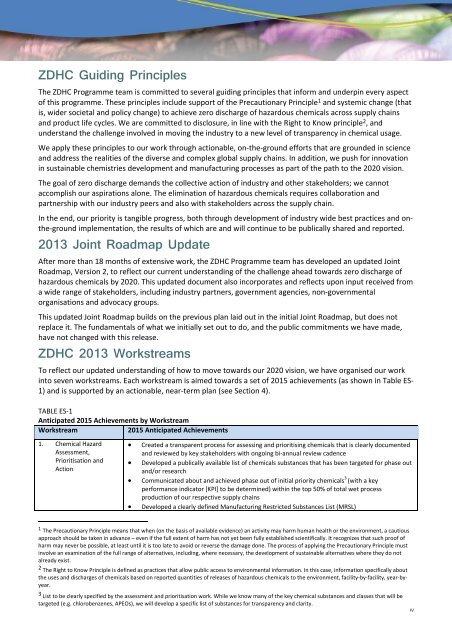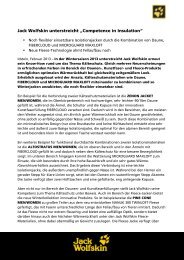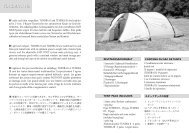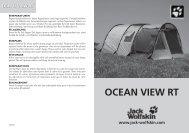The ZDHC Joint Roadmap - Jack Wolfskin
The ZDHC Joint Roadmap - Jack Wolfskin
The ZDHC Joint Roadmap - Jack Wolfskin
Create successful ePaper yourself
Turn your PDF publications into a flip-book with our unique Google optimized e-Paper software.
<strong>ZDHC</strong> Guiding Principles<br />
<strong>The</strong> <strong>ZDHC</strong> Programme team is committed to several guiding principles that inform and underpin every aspect<br />
of this programme. <strong>The</strong>se principles include support of the Precautionary Principle 1 and systemic change (that<br />
is, wider societal and policy change) to achieve zero discharge of hazardous chemicals across supply chains<br />
and product life cycles. We are committed to disclosure, in line with the Right to Know principle 2 , and<br />
understand the challenge involved in moving the industry to a new level of transparency in chemical usage.<br />
We apply these principles to our work through actionable, on‐the‐ground efforts that are grounded in science<br />
and address the realities of the diverse and complex global supply chains. In addition, we push for innovation<br />
in sustainable chemistries development and manufacturing processes as part of the path to the 2020 vision.<br />
<strong>The</strong> goal of zero discharge demands the collective action of industry and other stakeholders; we cannot<br />
accomplish our aspirations alone. <strong>The</strong> elimination of hazardous chemicals requires collaboration and<br />
partnership with our industry peers and also with stakeholders across the supply chain.<br />
In the end, our priority is tangible progress, both through development of industry wide best practices and onthe‐ground<br />
implementation, the results of which are and will continue to be publically shared and reported.<br />
2013 <strong>Joint</strong> <strong>Roadmap</strong> Update<br />
After more than 18 months of extensive work, the <strong>ZDHC</strong> Programme team has developed an updated <strong>Joint</strong><br />
<strong>Roadmap</strong>, Version 2, to reflect our current understanding of the challenge ahead towards zero discharge of<br />
hazardous chemicals by 2020. This updated document also incorporates and reflects upon input received from<br />
a wide range of stakeholders, including industry partners, government agencies, non‐governmental<br />
organisations and advocacy groups.<br />
This updated <strong>Joint</strong> <strong>Roadmap</strong> builds on the previous plan laid out in the initial <strong>Joint</strong> <strong>Roadmap</strong>, but does not<br />
replace it. <strong>The</strong> fundamentals of what we initially set out to do, and the public commitments we have made,<br />
have not changed with this release.<br />
<strong>ZDHC</strong> 2013 Workstreams<br />
To reflect our updated understanding of how to move towards our 2020 vision, we have organised our work<br />
into seven workstreams. Each workstream is aimed towards a set of 2015 achievements (as shown in Table ES‐<br />
1) and is supported by an actionable, near‐term plan (see Section 4).<br />
TABLE ES‐1<br />
Anticipated 2015 Achievements by Workstream<br />
Workstream<br />
2015 Anticipated Achievements<br />
1. Chemical Hazard<br />
Assessment,<br />
Prioritisation and<br />
Action<br />
<br />
<br />
<br />
<br />
Created a transparent process for assessing and prioritising chemicals that is clearly documented<br />
and reviewed by key stakeholders with ongoing bi‐annual review cadence<br />
Developed a publically available list of chemicals substances that has been targeted for phase out<br />
and/or research<br />
Communicated about and achieved phase out of initial priority chemicals 3 (with a key<br />
performance indicator [KPI] to be determined) within the top 50% of total wet process<br />
production of our respective supply chains<br />
Developed a clearly defined Manufacturing Restricted Substances List (MRSL)<br />
1 <strong>The</strong> Precautionary Principle means that when (on the basis of available evidence) an activity may harm human health or the environment, a cautious<br />
approach should be taken in advance – even if the full extent of harm has not yet been fully established scientifically. It recognizes that such proof of<br />
harm may never be possible, at least until it is too late to avoid or reverse the damage done. <strong>The</strong> process of applying the Precautionary Principle must<br />
involve an examination of the full range of alternatives, including, where necessary, the development of sustainable alternatives where they do not<br />
already exist.<br />
2 <strong>The</strong> Right to Know Principle is defined as practices that allow public access to environmental information. In this case, information specifically about<br />
the uses and discharges of chemicals based on reported quantities of releases of hazardous chemicals to the environment, facility‐by‐facility, year‐byyear.<br />
3 List to be clearly specified by the assessment and prioritisation work. While we know many of the key chemical substances and classes that will be<br />
targeted (e.g. chlorobenzenes, APEOs), we will develop a specific list of substances for transparency and clarity.<br />
IV

















